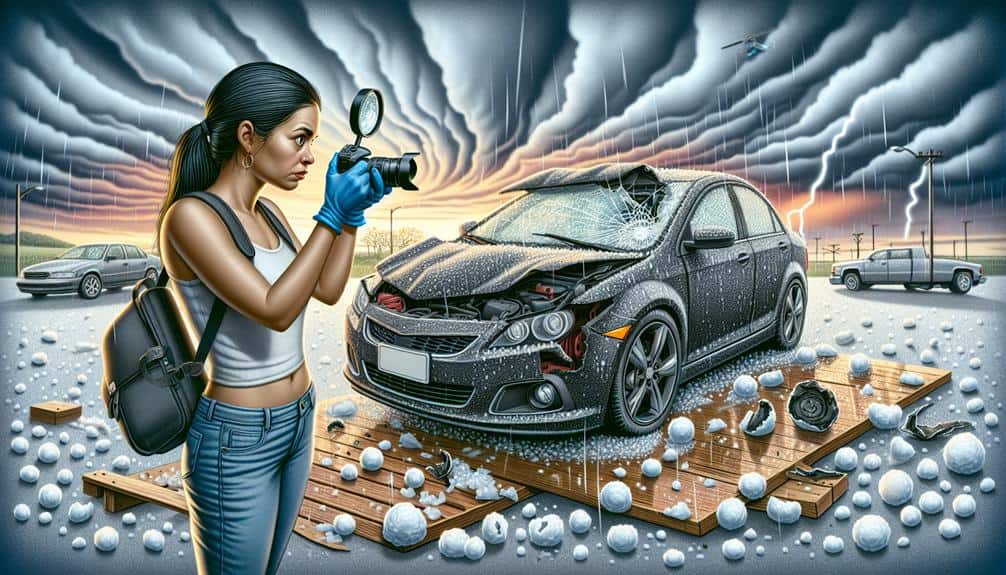When documenting storm vehicle damage, we should first capture high-quality photos by setting our cameras to the highest resolution, using natural light, and avoiding shadows or glare. Next, we must record detailed descriptions that cover the location, size, and nature of the damage, including before-and-after conditions and any relevant conversations. Finally, organizing and storing our evidence digitally with labeled files and a clear folder structure guarantees it's secure and accessible. By following these practices, we can streamline our claims and avoid disputes. Stay tuned to learn how to make these steps even more effective.
Key Points
- Capture high-resolution photos from multiple angles to cover all vehicle damage.
- Use natural lighting to avoid shadows and glare in your photos.
- Record detailed descriptions, noting the location, size, and nature of the damage.
- Organize evidence in a secure, cloud-based storage system with clear labeling.
Capture High-Quality Photos
To accurately document storm damage to your vehicle, we'll start by capturing high-quality photos. First, we need to make sure our camera or smartphone is set to the highest resolution quality. This guarantees that every detail is visible, which is essential for any insurance claims or repair assessments.
Next, let's focus on lighting angles. Natural light works best, so taking photos during daylight hours is ideal. Position the vehicle so the light source illuminates the damaged areas without causing harsh shadows or glare. If natural light isn't an option, use a bright, even artificial light source and adjust the angles to minimize reflection and shadow.
We should take photos from multiple perspectives. Start with wide shots to capture the overall scene, then move closer for detailed images of specific damage. Pay attention to capturing the damage from different angles to provide a thorough view.
Don't forget to photograph identifying features like the license plate and any distinctive marks to verify the vehicle's identity.
Record Detailed Descriptions
Why is it important that we record detailed descriptions of the storm damage to our vehicle?
Precise records and thorough descriptions are vital for insurance claims and potential legal matters. By taking detailed notes, we guarantee that every scratch, dent, and broken part is documented. This level of detail can prevent disputes and strengthen our case for a fair settlement.
When we describe the damage, we need to be as accurate as possible. Note the location, size, and nature of each damage. For instance, 'three-inch dent on the front left fender, with paint chipping' is more informative than 'dent on fender.'
Detailed notes should include the condition of various parts before and after the storm. This helps in creating a clear timeline and supports our claim with solid evidence.
We should also maintain complete logs of all interactions and observations. Document dates, times, and conversations with insurance representatives or repair shops. Precise records will help us track the progress of our claim and resolve any discrepancies.
Organize and Store Evidence
After recording detailed descriptions, we must organize and store all evidence systematically to guarantee it's easily accessible when needed. First, let's utilize digital storage solutions for photographs, videos, and scanned documents. Cloud-based services ensure our files are secure from physical damage and can be accessed from anywhere.
Proper labeling is essential. We should name each file with specific identifiers, such as the vehicle's license plate number, date of the storm, and a brief description of the damage. This practice prevents confusion and facilitates quick retrieval. For instance, a file might be labeled as 'ABC1234_20231005_HailDamage.'
We also need to create folders for each vehicle and subfolders for different types of evidence. This hierarchical structure helps us locate specific pieces of evidence without sifting through unrelated files.
Additionally, maintaining a digital log or spreadsheet to track all evidence and its locations can be extremely advantageous.
Frequently Asked Questions
How Soon After the Storm Should I Document the Vehicle Damage?
Timing is everything. We should document the vehicle damage as soon as possible after the storm. This guarantees accuracy and detail, which are essential for any claims. The significance of acting swiftly can't be overstated.
Should I Contact My Insurance Company Before Starting the Documentation?
Let's contact our insurance company before starting the documentation process. This guarantees our insurance claim's timing and accuracy. Coordinating early helps us follow their guidelines, making the process smoother and avoiding delays in getting the help we need.
What Tools or Apps Are Recommended for Documenting Vehicle Damage?
Let's arm ourselves with the right tools to capture the storm's wrath. For photo documentation and note taking, we recommend CamScanner. For video recording and sketching, try Evernote. Both apps offer freedom and precision.
How Can I Ensure That My Documentation Is Admissible in an Insurance Claim?
To guarantee our documentation is admissible in an insurance claim, we must consider legal implications and evidence collection. Use clear photography tips and maintain meticulous document organization. This approach strengthens our claim's validity and supports our freedom.
Are There Specific Angles or Parts of the Vehicle I Should Focus On?
Did you know 70% of claims are denied due to insufficient documentation? We should focus on key features like bumpers, windows, and tires. Guarantee clear lighting conditions to capture detailed images for a successful claim.


